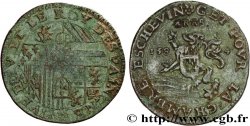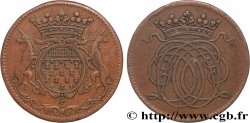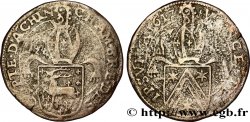E-auction 63-29958 - fjt_012660 - ARTOIS - NOBLESSE J. Faveau, abbé de l’abbaye d’Achin 1612
Sie müssen angeschlossen sein und von cgb.fr genehmigt werden, um in einer E-Auktion teilzunehmen.Melden Sie sich an, um zu wetten..Die Kontobestätigungen sind innerhalb von 48 Stunden nach Ihrer Anmeldung gemacht.Warten Sie nicht bis die letzten zwei Tage vor dem Abschluss eines Verkaufs, um Ihre Registrierung abzuschließen. Klickend "BIETEN" verpflichten Sie sich vertraglich, diesen Artikel zu kaufen und Sie nehmen ohne Reserve die allgemeinen Verkaufsbedingungen für den e-auctions zu cgb.fr an.
Der Verkauf wird an der Zeit auf der Übersichtsseite angezeigt geschlossen werden. Angebote, die nach der Schließung Zeit empfangen sind, werden nicht gültig.
Bitte beachten Sie, dass die Fristen für die Einreichung Ihres Angebots auf unsere Server können variieren und es kann zur Ablehnung Ihres Angebots entstehen, wenn es in den letzten Sekunden des Verkaufs gesendet wird. Die Angebote sollen mit ganzer Zahl ausgeführt sein, Sie können Kommas oder des Punktes in Ihrem Angebot nicht erfassen. Bei Fragen klicken Sie hier, um einen Blick auf die FAQ E-Auktionen.
KEINE ANSCHAFFUNGSKOSTEN FÜR DIE KÄUFER.
KEINE ANSCHAFFUNGSKOSTEN FÜR DIE KÄUFER.
| Schätzung : | 75 € |
| Preis : | 41 € |
| Höchstgebot : | 45 € |
| Verkaufsende : | 30 Juni 2014 18:52:00 |
| Bieter : | 5 Bieter |
Type : J. Faveau, abbé de l’abbaye d’Achin
Datum: 1612
Metall : Kupfer
Durchmesser : 29,3 mm
Stempelstellung : 3 h.
Rand lisse
Seltenheitsgrad : R2
N° im Nachschlagewerk :
Vorderseite
Titulatur der Vorderseite VINCE TE IPSVM A 1612.
Beschreibung Vorderseite Armes de J. Faveau avec la mitre.
Übersetzung der Vorderseite Triomphe de toi-même.
Rückseite
Titulatur der Rückseite CHAMBRE DES COPTE DACHIN.
Beschreibung Rückseite Armes de l'abbaye.
Kommentare
Un rappel historique rapide sans omettre le vandalisme révolutionnaire : “ L'histoire du village de Pecquencourt est liée à celle de l'abbaye d'Anchin, fondée en 1079 dans une île de la Scarpe au milieu des marais, dont l'église, commencée en 1181, fut consacrée en 1250.
Doté de nombreux bien dans la région, l'abbaye contribua puissamment au défrichement et à l'assainissement de la vallée : elle joua surtout par la réforme de Cluny qu'elle propagea en Flandre et en Hainaut, un rôle des plus importants dans la vie religieuse et intellectuelle du moyen âge.
En 1566 elle échappa au pillage des iconoclastes qui venaient de ravager l'abbaye de Marchiennes, mais en 1579 elle fut occupée ainsi que Pecquencourt par les bandes du parti des "Malcontents" qui s'y maintinrent jusqu'en 1592 : l'abbaye fut supprimée à la Révolution, vendue comme bien national en 1792 et démolie.
Les Autrichiens occupèrent Pecquencourt et Anchin en mai 1793. De nos jours Pecquencourt est devenu un centre important pour l'industrie minière ; c'est l'une des communes du Nord où la proportion d'étrangers est la plus forte. Cette commune faisait partie du Hainaut et du Diocèse d'Arras. L'abbaye était en Artois.
Le fonds ancien de la ville de Douai est richement doté de 1800 manuscrits provenant des confiscations révolutionnaires. Plus de 300 ont appartenu à l'Abbaye d'Anchin et près de 260 à celle de Marchiennes. 70 viennent des monastères ou séminaires britanniques nombreux à Douai. “ http://www.mamet-dom.net/Aides/Abbaye_d_Anchin.htm.
A quick historical reminder without omitting revolutionary vandalism: “The history of the village of Pecquencourt is linked to that of the abbey of Anchin, founded in 1079 on an island in the Scarpe in the middle of the marshes, whose church, begun in 1181, was consecrated in 1250.
Endowed with numerous properties in the region, the abbey contributed powerfully to the clearing and sanitation of the valley: it played, above all, through the Cluny reform which it propagated in Flanders and Hainaut, a most important role in the religious and intellectual life of the Middle Ages..
In 1566 it escaped the pillage of the iconoclasts who had just ravaged the abbey of Marchiennes, but in 1579 it was occupied, along with Pecquencourt, by bands of the \\\"Malcontents\\\" party who remained there until 1592: the abbey was suppressed during the Revolution, sold as national property in 1792 and demolished..
The Austrians occupied Pecquencourt and Anchin in May 1793. Today, Pecquencourt has become an important center for the mining industry; it is one of the communes in the North where the proportion of foreigners is the highest.. This commune was part of Hainaut and the Diocese of Arras. The abbey was in Artois.
The old collection of the city of Douai is richly endowed with 1800 manuscripts from revolutionary confiscations. More than 300 belonged to the Abbey of Anchin and nearly 260 to that of Marchiennes. 70 come from the numerous British monasteries or seminaries in Douai. “ http://www. mamet-dom. net/Aids/Abbaye_d_Anchin. htm
Doté de nombreux bien dans la région, l'abbaye contribua puissamment au défrichement et à l'assainissement de la vallée : elle joua surtout par la réforme de Cluny qu'elle propagea en Flandre et en Hainaut, un rôle des plus importants dans la vie religieuse et intellectuelle du moyen âge.
En 1566 elle échappa au pillage des iconoclastes qui venaient de ravager l'abbaye de Marchiennes, mais en 1579 elle fut occupée ainsi que Pecquencourt par les bandes du parti des "Malcontents" qui s'y maintinrent jusqu'en 1592 : l'abbaye fut supprimée à la Révolution, vendue comme bien national en 1792 et démolie.
Les Autrichiens occupèrent Pecquencourt et Anchin en mai 1793. De nos jours Pecquencourt est devenu un centre important pour l'industrie minière ; c'est l'une des communes du Nord où la proportion d'étrangers est la plus forte. Cette commune faisait partie du Hainaut et du Diocèse d'Arras. L'abbaye était en Artois.
Le fonds ancien de la ville de Douai est richement doté de 1800 manuscrits provenant des confiscations révolutionnaires. Plus de 300 ont appartenu à l'Abbaye d'Anchin et près de 260 à celle de Marchiennes. 70 viennent des monastères ou séminaires britanniques nombreux à Douai. “ http://www.mamet-dom.net/Aides/Abbaye_d_Anchin.htm.
A quick historical reminder without omitting revolutionary vandalism: “The history of the village of Pecquencourt is linked to that of the abbey of Anchin, founded in 1079 on an island in the Scarpe in the middle of the marshes, whose church, begun in 1181, was consecrated in 1250.
Endowed with numerous properties in the region, the abbey contributed powerfully to the clearing and sanitation of the valley: it played, above all, through the Cluny reform which it propagated in Flanders and Hainaut, a most important role in the religious and intellectual life of the Middle Ages..
In 1566 it escaped the pillage of the iconoclasts who had just ravaged the abbey of Marchiennes, but in 1579 it was occupied, along with Pecquencourt, by bands of the \\\"Malcontents\\\" party who remained there until 1592: the abbey was suppressed during the Revolution, sold as national property in 1792 and demolished..
The Austrians occupied Pecquencourt and Anchin in May 1793. Today, Pecquencourt has become an important center for the mining industry; it is one of the communes in the North where the proportion of foreigners is the highest.. This commune was part of Hainaut and the Diocese of Arras. The abbey was in Artois.
The old collection of the city of Douai is richly endowed with 1800 manuscripts from revolutionary confiscations. More than 300 belonged to the Abbey of Anchin and nearly 260 to that of Marchiennes. 70 come from the numerous British monasteries or seminaries in Douai. “ http://www. mamet-dom. net/Aids/Abbaye_d_Anchin. htm








 Berichten über einen Fehler
Berichten über einen Fehler Die Seite drucken
Die Seite drucken Teilen meiner Auswahl
Teilen meiner Auswahl Stellen Sie eine Frage
Stellen Sie eine Frage Einlieferung/Verkauf
Einlieferung/Verkauf
 Details
Details










